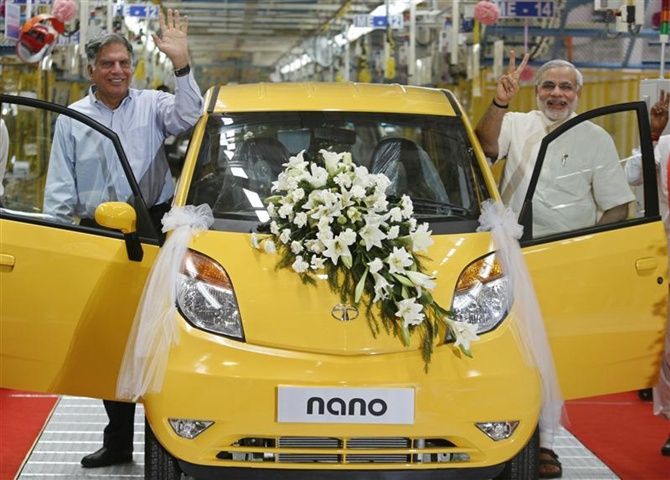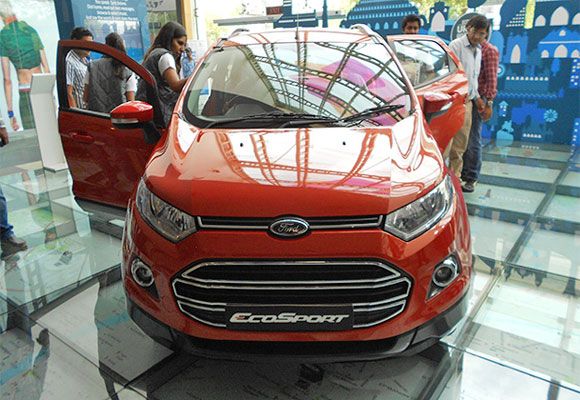With Ford's plant set for action, and plans of other manufacturers, regional belt set to race into major export league.

Sitting outside the panchayat office at Bol, close to Ahmedabad, Vishnubhai Thakor says about Rs 900 crore has flown into his village alone, thanks to land sales to government agencies for setting up the Sanand Industrial Estate.
The panchayat building carries an interesting board, that of 'Nano Nagari'. Indeed, since the much-talked small-car project was parked here, the neighbourhood has not only seen money flowing in but has catapulted into the big league of automobile industry hubs.
Not only in the country - it is vying for the label of one of the noted automotive belts in the Asia-Pacific region. Rough calculations show the Sanand-Hansalpur-Vithalapur belt is likely to have installed annual car manufacturing capacity of 1.46 million vehicles and around three million two-wheelers in the coming three to four years.

With planned expansions in place, the figure would touch 2.3 million vehicles annually in the next eight to 10 years.
Add General Motors' facility at Halol (140 km from here) near Vadodara, where the company currently has a capacity of around 110,000 cars annually. In comparison, the Pune-Talegaon-Chakan belt has a capacity for about 1.1 million cars and three million two-wheelers and three-wheelers.
The Maraimalai Nagar-Oragadam belt, near Chennai, can roll out about 1.25 million vehicles. The Gurgaon-Manesar belt in Haryana is the biggest, where Maruti Suzuki alone has an installed capacity of 1.5 million vehicles annually.

Advantage
However, say analysts, existing hubs like Gurgaon-Manesar have become saturated, with limited scope for future growth. In comparison, the areas around Hansalpur and Vithalapur are relatively nascent and can attract more automotive projects in the coming years.
According to state government sources, officials from at least two multinational car companies had recently visited Gujarat and surveyed sites. As US-based automobile maker Ford Motor's Indian subsidiary, Ford India, readies for an inauguration in the last week of March, there are two immediate takeaways.
One, with Ford planning to make about 800 vehicles daily at Sanand initially (net installed capacity of 240,000 cars annually), together with neighbour Tata Motors planning to roll out new models from its Nano factory, the production at Sanand is easily going to cross 200,000 units during 2015, bringing cheer to ancillary units.

Second, with Ford planning to develop Sanand into a major export hub for its vehicles, and Maruti Suzuki India joining here by 2017, the Sanand-Hansalpur belt can help India stamp its brand as a low-cost yet quality vehicle maker in the coming years.
While a detailed questionnaire to Ford India remained unanswered, industry sources indicated the company was actively eyeing how to expand its export footprint from India, from 50 countries now to over 100 in the coming years.
To keep in line with global quality standards, Ford has already taken care to increase automation levels at the Sanand facility. The body-shop is almost 95 per cent automated, among the highest in the Asia-Pacific and Africa region.
According to sources, automation levels in Ford's plants across the globe are only around 30 per cent. Despite the high automation levels, its Sanand unit is expected to employ around 5,000 people when fully operational.
Sanand's proximity to the port (there are plans to extend the nearby rail network around Sanand and Hansalpur right up to the manufacturing plants, connecting these to the ports of Mundra and Pipavav in the state), as well as Gujarat's image of pro-active governance, coupled with abundant power supplies, can all act to help position itself as a favoured destination for automotive players.

Issues
Abdul Majeed, partner, PwC India, says there are three major hurdles in the way of India becoming a major automobile manufacturing nation. These are a complex tax structure, high infrastructure costs (power) and complicated labour laws.
"If the government can take pro-active steps in these areas, India can emerge as a major manufacturing destination for auto majors. In that, Sanand can play an important role, as the existing hubs in Maharashtra and Haryana are already saturated," he says.
He adds that the recent political turmoil in Thailand have prompted car majors to scout for other places in the Asia-Pacific, such as Malaysia or Indonesia.
Automation, thinks V Mehta, director general of the Automotive Component Manufacturers Association, is also an answer to rising industrial relation problems and labour disputes. This necessarily does not mean a cut on labour use.
Mehta says, "It is to ensure good quality, adhering to global standards, and lesser fatigue for the operator." Some of Ford's plants across developed nations like the US and Canada employ 3,500-4,000 people.

Ford
Multinationals like Ford India, planning to position India as a centre of excellence for small cars and low displacement engines for both the home and export markets, can play a big role in changing Gujarat's landscape to a major car exporter.
Ford India was established in 1995 as a wholly-owned subsidiary of Ford Motor Company. Since then, Ford has invested about $2 billion in India to expand its manufacturing facilities, of which nearly $1 billion has flown into Sanand.
The company's Chennai facility makes the popular EcoSport, along with facilities across Brazil, China and Thailand.
Ford India had made an investment of $142 million to produce EcoSport at the facility, which also produces the Figo hatchback, the Endeavour premium SUV and Fiesta sedan.
The company's focus on exports is evident from that fact that while its domestic sales dipped 10.5 per cent during the April to February period in 2014-15, its exports grew 66.8 per cent.
At Sanand, the company plans to make a hatchback based on the Figo platform, a sub-four metre sedan and a new generation SUV.
The importance of the India market for Ford globally can be gauged from the fact that its global chief executive, Mark Fields (who took charge on July 1 last year), had visited India and met the Prime Minister in June 2014 as the CEO-designate.
Prime Minister Narendra Modi is believed to have urged him to develop India into a large-scale manufacturing and export hub for the company.
With countries like China showing traction in domestic demand for Ford (where it opened its third assembly plant in Chongqing in November 2014, and another plant at Hangzhou set to be commissioned, boosting its total capacity to 1.5 million vehicles annually in that country), places like India are likely to emerge as strong contenders to being low-cost manufacturing hubs for exports around the globe.











